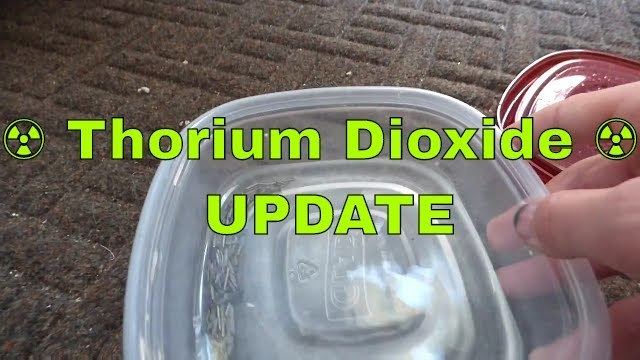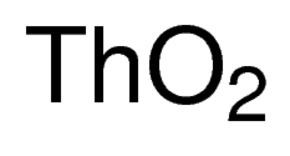Formula ThO2 Density 10 g/cm³ Boiling point 4,400 °C | Melting point 3,390 °C Molar mass 264.04 g/mol Appearance white solid | |
 | ||
Related compounds | ||
Thorium dioxide (ThO2), also called thorium(IV) oxide, is a crystalline solid, often white or yellow in color. Also known as thoria, it is produced mainly as a by-product of lanthanide and uranium production. Thorianite is the name of the mineralogical form of thorium dioxide. It is moderately rare and crystallizes in an isometric system. The melting point of thorium oxide is 3300 °C – the highest of all known oxides. Only a few elements (including tungsten and carbon) and a few compounds (including tantalum carbide) have higher melting points. All thorium compounds are radioactive.
Contents
- How to make thorium dioxide
- Structure and reactions
- Nuclear fuels
- Alloys
- Catalysis
- Radiocontrast agents
- Lamp mantles
- Glass manufacture
- References

How to make thorium dioxide
Structure and reactions

Thoria exists as two polymorphs. Thoria has the fluorite crystal structure. This is uncommon among binary dioxides (other examples include cerium dioxide, hafnium dioxide, uranium dioxide and plutonium dioxide). The band gap of thoria is about 6 eV. The tetragonal form of thoria is also known.
At extremely high temperatures, it evolves oxygen, giving the black monooxide ThO.
Nuclear fuels

Thorium dioxide (thoria) can be used in nuclear reactors as ceramic fuel pellets, typically contained in nuclear fuel rods clad with zirconium alloys. Thorium is not fissile (but is "fertile", breeding fissile uranium-233 under neutron bombardment); hence, it must be used as a nuclear reactor fuel in conjunction with fissile isotopes of either uranium or plutonium. This can be achieved by blending thorium with uranium or plutonium, or using it in its pure form in conjunction with separate fuel rods containing uranium or plutonium. Thorium dioxide offers advantages over conventional uranium dioxide fuel pellets, because of its higher thermal conductivity (lower operating temperature), considerably higher melting point, and chemical stability (does not oxidize in the presence of water/oxygen, unlike uranium dioxide).

Thorium dioxide can be turned into a nuclear fuel by breeding it into uranium-233 (see below and refer to the article on thorium for more information on this). The high thermal stability of thorium dioxide allows applications in flame spraying and high-temperature ceramics.
Alloys
Thorium dioxide is used as a stabilizer in tungsten electrodes in TIG welding, electron tubes, and aircraft engines. As an alloy, thoriated tungsten metal is not easily deformed because the high-fusion material thoria augments the high-temperature mechanical properties, and thorium helps stimulate the emission of electrons (thermions). It is the most popular oxide additive because of its low cost, but is being phased out in favor of non-radioactive elements such as cerium, lanthanum and zirconium.
Thoria dispersed nickel finds its applications in various high temperature operations like combustion engines because it is a good creep resistant material. It can also be used for hydrogen trapping.
Catalysis
Thorium dioxide has almost no value as a commercial catalyst, but such applications have been well investigated. It is a catalyst in the Ruzicka large ring synthesis. Other applications that have been explored include petroleum cracking, conversion of ammonia to nitric acid and preparation of sulfuric acid.
Radiocontrast agents
Thorium dioxide was the primary ingredient in the once-common radiocontrast agent Thorotrast. Its use was abandoned when it was found to be a carcinogen, sometimes causing cholangiocarcinoma. As many as 10 million patients were treated with Thorotrast. It offered excellent image enhancement and almost no immediate side effects but was associated with a significantly higher incidence of cancer later in life, often occurring decades following its administration (with one large study showing a median life-expectancy reduction of 14 years experienced by those treated with it). Today, iodinated solutions (injected) or barium sulfate (ingested) are the standard X-ray contrast agents.
Lamp mantles
Another major use in the past was in gas mantle of lanterns, which are composed of 99 percent ThO2 and 1% cerium(IV) oxide. Even as late as the 1980s it was estimated that about half of all ThO2 produced (several hundred tonnes per year) was used for this purpose. Some mantles still use thorium, but yttrium oxide (or sometimes zirconium oxide) is used increasingly as a replacement. Thorium dioxide is a Welsbach material. It has been suggested that these chemicals could be sprayed into the upper atmosphere to reflect sunlight and thus lower the global temperature. However, due to its density and radioactivity, thorium dioxide would be a poor choice for this application.
Glass manufacture
Thorium dioxide was formerly added to glasses during manufacture to increase their refractive index, producing thoriated glass with up to 40% ThO2 content. These glasses were used in the construction of high-quality photographic lenses. However, the radioactivity of the thorium caused both a safety and pollution hazard and self-degradation of the glass (turning it yellow or brown over time). Lanthanum oxide has replaced thorium dioxide in almost all modern high-index glasses.
